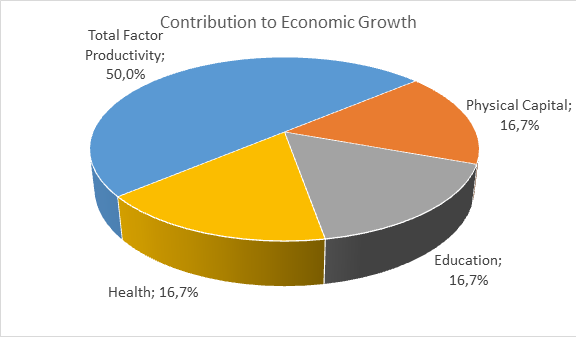Ukrainian policy dialog on healthcare system creates an impression that this system is a drain on the public funds and healthcare expenditures should be cut as much as possible. This ignores two important things. First, the healthcare system is one of the major reasons for people to pay taxes. If one wants to cut healthcare funding, one has to clearly articulate how much less the government will take from people in the form of taxes. Second, health is not only an expenditure good but also an investment and important factor for economic growth.
In this post, we would like to highlight the latter, putting health on the priority agenda for the new government. Economic literature puts health on par with such determinants of economic growth as physical capital and education (Lopez-Casasnovas et al. 2007, Bloom and Canning 2008, Shastry and Weil 2003):
The impact of population health on economic growth can work through several channels:
(i) labor productivity – healthy workers do not lose as much time due to illness and are more effective when working;
(ii) education – health in childhood has a direct impact on cognitive development and school attendance, poor health of parents can drain family budget and undermine child’s educational prospects;
(iii) savings – longer healthy life works as a great incentive to save for later years, while poor health can force families to spend down their savings, sell property and end up in long-term poverty.
Ukrainians live short lives complicated by a wide range of chronic conditions. Following the economic hardships of 1990s, life expectancy dropped considerably. Currently, it is 64 for males and 75 for females – 6-9 years shorter than in Central Europe and 8-13 years shorter than in Western Europe. Life expectancy is a composite measure but there is almost no health condition which has shown an improvement over the two decades in Ukraine: TB/HIV/AIDS epidemic, a surge in sexually transmitted diseases, cardiovascular diseases and poor cancer outcomes mainly due to late diagnosis (Lekhan et al. 2004, 2010). This is especially tragic because deaths from TB, cancer, cardio-vascular diseases, as well as many other conditions, which are all avoidable given the current state of medical knowledge (Nizalova and Castelli 2011).
Currently there are three most pressing problems in the population health, which are directly related to the country’s workforce productivity and survival: non-communicable diseases (NCDs), infectious diseases, and health impacts of war.
NCDs epidemic. Not only Ukrainians die younger (in Europe only Russia “outperforms” us), but we also have fewer years lived in good health (13% of lives are spent in the states less than perfect). In Ukraine:
- Nearly 31% of 30-year-old-people die before their 70th birthday from an NCD (the average in the world is 22%).
- According to Ukraine’s Statistical office, NCDs—cardiovascular, cancer, respiratory, and diabetes—cause approximately 82% of all deaths in Ukraine.
- At least half of deaths before the age of 75 are avoidable through adequate prevention and treatment.
- One fourth of Ukrainians aged 18-65 has at least one chronic disease or condition, around 7 % have multiple.
Bringing eradicated diseases back to life. In addition to ongoing TB epidemics and the growth of multi-drug resistant TB rates and HIV/AIDS, the country is facing significant risks of bringing previously eradicated diseases such as smallpox, diphtheria, polio and others, back to life. According to the recent post of Evgeny Komarovsky on his facebook page, the biological safety of the country is undermined as the documented low vaccination rates include those who did not really get vaccinated but got the needed statement in their medical documents. Yukie Mokuo, UNICEF’s representative in Ukraine, says that the rate of immunisation in the country resembles that seen in destitute sub-Saharan African countries.
War and economic turbulence. The persistent population health crisis is amplified by the war and economic recession. The conflict is killing about 10 people per day. The last UN report calculated as many as 4035 people dead and 9336 wounded. Many of the wounded are becoming disabled, others face long-lasting mental health issues. The risks of spread of socially dangerous diseases, like TB and HIV, are very high, as both government and non-government programs to fight them are paralyzed in DNR and LNR, regions with the highest burden of these diseases. UN are reporting that as of November, 20th, nearly 60 thousands of HIV-positive, and 12 thousands of patients with Multi-drug-resistant Tuberculosis are at high risk to lose the chance of getting life-saving drugs.
Statistics also doesn`t reflect the insanitary conditions in the East, which can bring back even older infections. Disruptions of clean water supply, improper treatment of the dead, interrupted garbage removal, shortages of fresh food, problems with heating and light experienced in the East will have an inevitable negative impact on population health.
In summary, the nation experiences the NCD and TB/HIV epidemics, while risking to also falling a prey to almost forgotten infectious diseases because of the negligence to vaccination. The war is exacerbating the problem by hampering the existing healthcare system and creating further burden through casualties and disability for current and future generations. This dire population health condition requires a set of immediate and systemic policy actions. Ukraine will have hard time to grow consistently if we do not implement a new healthcare system focused on improving population health as a key investment into Ukraine’s future.
Notes
1. Guillem Lopez-Casasnovas, Berta Rivera, and Luis Currais (ed.), 2007. “Health and Economic Growth: Findings and Policy Implications,” MIT Press Books, The MIT Press, edition 1, volume 1, number 0262622122, December.
2. David E. Bloom and David Canning. 2008 Population Health and Economics Growth. Commission on Growth and Development Working Paper No. 24. http://siteresources.worldbank.org/EXTPREMNET/Resources/489960-1338997241035/Growth_Commission_Working_Paper_24_Population_Health_Economic_Growth.pdf
3. K. Shastry and D. N. Weil. 2003. “How Much of Cross‐Country Income Variation Is Explained by Health?” Journal of the European Economic Association 1: 387–96.
4. Olena Nizalova and Adriana Castelli, 2011. “Avoidable mortality: what it means and how it is measured,” Working Papers 063, Centre for Health Economics, University of York.
Attention
The authors do not work for, consult to, own shares in or receive funding from any company or organization that would benefit from this article, and have no relevant affiliations





